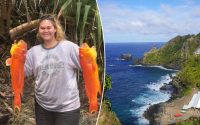Astronauts will soon live and work on the moon: NASA
That’s one small bed for man.
As NASA eagerly awaits putting its first human presence on the moon since the Apollo missions of half a century ago, the space agency said it is on pace to make the lunar landscape livable for astronauts by 2030, the BBC reported.
“Certainly, in this decade, we are going to have people living for durations, depending on how long we will be on the surface. They will have habitats, they will have rovers on the ground,” Howard Hu, head of NASA’s Orion lunar spacecraft program, told the TV channel.
The Orion rocket — which recently launched with three test dummies aboard for a 26-day test flight from Cape Canaveral — is a vessel working in tandem with NASA’s Artemis missions that will historically return astronauts to the moon.
“We’re working toward a sustainable program and this is the vehicle that will carry the people that will land us back on the moon again,” Hu said. “We are going to be sending people down to the surface, and they are going to be living on that surface and doing science.”

Similar to what Neil Armstrong said while touching the lunar surface for the first time with Apollo 11, Hu said this will be a major “step” for future deep space missions.
“It’s the first step we’re taking to long-term deep-space exploration, for not just the United States but for the world,” he said. “We are going back to the moon.”
It’s also a pivotal component for the to-be-constructed Gateway — an orbital outpost which will bring “essential support for long-term human return to the lunar surface and serves as a staging point for deep space exploration,” according to NASA.


Over the next few years as more manned Artemis missions come to be — and as the first female astronaut is slated to go to the moon — the space rock will be much more of a jumping off point for the deeper realms of our solar system.
Hu said that moving forward the goal is to get to Mars.
“That is a bigger stepping stone, a two-year journey, so it’s going to be really important to learn beyond our Earth orbit.”


